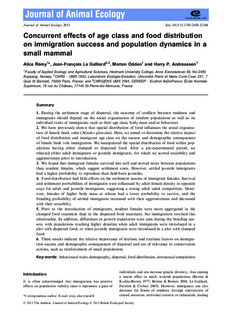Concurrent effects of age class and food distribution on immigration success and population dynamics in a small mammal
Journal article, Peer reviewed
Permanent lenke
http://hdl.handle.net/11250/134658Utgivelsesdato
2013Metadata
Vis full innførselSamlinger
Originalversjon
Remy, A. M. J., Le Galliard, J.-F., Odden, M., & Andreassen, H. P. (2014). Concurrent effects of age class and food distribution on immigration success and population dynamics in a small mammal. Journal of Animal Ecology. doi: 1365-2656.12184 10.1111/1365-2656.12184Sammendrag
1. During the settlement stage of dispersal, the outcome of conflicts between residents and
immigrants should depend on the social organization of resident populations as well as on
individual traits of immigrants, such as their age class, body mass and/or behaviour.
2. We have previously shown that spatial distribution of food influences the social organization
of female bank voles (Myodes glareolus). Here, we aimed to determine the relative impact
of food distribution and immigrant age class on the success and demographic consequences
of female bank vole immigration. We manipulated the spatial distribution of food within populations
having either clumped or dispersed food. After a pre-experimental period, we
released either adult immigrants or juvenile immigrants, for which we scored sociability and
aggressiveness prior to introduction.
3. We found that immigrant females survived less well and moved more between populations
than resident females, which suggest settlement costs. However, settled juvenile immigrants
had a higher probability to reproduce than field-born juveniles.
4. Food distribution had little effects on the settlement success of immigrant females. Survival
and settlement probabilities of immigrants were influenced by adult female density in opposite
ways for adult and juvenile immigrants, suggesting a strong adult–adult competition. Moreover,
females of higher body mass at release had a lower probability to survive, and the
breeding probability of settled immigrants increased with their aggressiveness and decreased
with their sociability.
5. Prior to the introduction of immigrants, resident females were more aggregated in the
clumped food treatment than in the dispersed food treatment, but immigration reversed this
relationship. In addition, differences in growth trajectories were seen during the breeding season,
with populations reaching higher densities when adult immigrants were introduced in a
plot with dispersed food, or when juvenile immigrants were introduced in a plot with clumped
food.
6. These results indicate the relative importance of intrinsic and extrinsic factors on immigration
success and demographic consequences of dispersal and are of relevance to conservation
actions, such as reinforcement of small populations.
